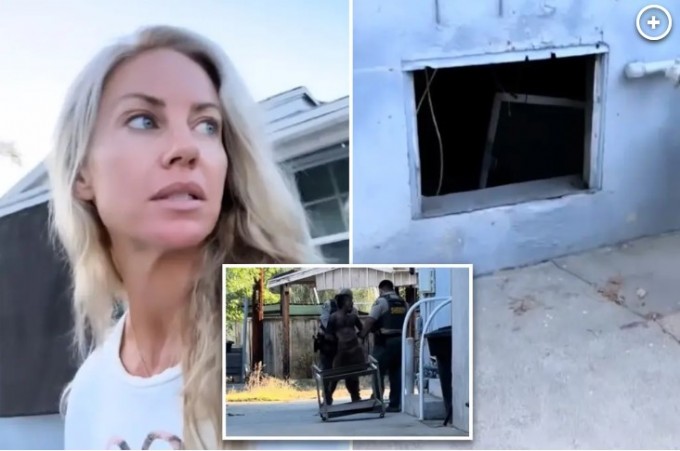Fabulous
Startling Encounter: Woman Discovers Unwanted House Guest, Faces Unjust Backlash
The incident sheds light on the growing issue of "phrogging," where individuals trespass onto properties and establish hidden living spaces. However, the resident's decision to report the intruder has led to accusations of insensitivity and racism, sparking a broader conversation about societal attitudes, biases, and the complex nature of homelessness.
Unveiling the Unwanted Guest: Ashly Guardino, a Lake Elsinore resident, woke up to peculiar noises one Saturday, assuming her landlord was conducting routine roof repairs. To her shock, she found an arm reaching out from under her house, belonging to an unknown man who had been secretly living there for months. Guardino shared her unsettling experience on TikTok, a social media platform, which rapidly gained traction and garnered over 6.2 million views.
The "Phrogging" Phenomenon: Coined from a frog's tendency to hop from place to place, "phrogging" has emerged as a concerning trend where individuals exploit properties to establish covert living spaces. This phenomenon has become increasingly alarming for law enforcement agencies, particularly in regions grappling with housing shortages and favorable weather conditions that make outdoor living more feasible.

Guardino's Encounter: Guardino's traumatic encounter shed light on the life of the squatter, revealing him to be a 26-year-old parolee with a history of seeking refuge beneath homes. Following a tumultuous path that included setting his ex-partner's house ablaze and serving prison time, he resorted to concealing himself under Guardino's residence. This incident underscores the complexity of criminal rehabilitation, mental health support, and housing stability for individuals with troubled pasts.
The "phrogging" trend represents more than just unauthorized occupancy; it's a reflection of deeper societal challenges. The scarcity of affordable housing and resources for vulnerable populations leaves some individuals with limited options, pushing them to adopt unconventional means to secure shelter. As housing costs rise and rental availability diminishes, marginalized individuals who lack stable support networks may find themselves resorting to trespassing and hidden habitation out of desperation.
However, Guardino's actions also illuminate the intricate web of public sentiment, personal safety, and community responsibility. While her decision to alert authorities stemmed from legitimate concerns, the subsequent allegations of insensitivity and racism underscore the complexities of addressing such scenarios. This case raises questions about striking a balance between safeguarding individuals and property and considering the underlying circumstances of those involved.

Latest News
The incident sheds light on the growing issue of "phrogging," where individuals trespass onto properties and establish hidden living spaces. However, the resident's decision to report the intruder has led to accusations of insensitivity and racism, sparking a broader conversation about societal attitudes, biases, and the complex nature of homelessness.
Unveiling the Unwanted Guest: Ashly Guardino, a Lake Elsinore resident, woke up to peculiar noises one Saturday, assuming her landlord was conducting routine roof repairs. To her shock, she found an arm reaching out from under her house, belonging to an unknown man who had been secretly living there for months. Guardino shared her unsettling experience on TikTok, a social media platform, which rapidly gained traction and garnered over 6.2 million views.
The "Phrogging" Phenomenon: Coined from a frog's tendency to hop from place to place, "phrogging" has emerged as a concerning trend where individuals exploit properties to establish covert living spaces. This phenomenon has become increasingly alarming for law enforcement agencies, particularly in regions grappling with housing shortages and favorable weather conditions that make outdoor living more feasible.

Guardino's Encounter: Guardino's traumatic encounter shed light on the life of the squatter, revealing him to be a 26-year-old parolee with a history of seeking refuge beneath homes. Following a tumultuous path that included setting his ex-partner's house ablaze and serving prison time, he resorted to concealing himself under Guardino's residence. This incident underscores the complexity of criminal rehabilitation, mental health support, and housing stability for individuals with troubled pasts.
The "phrogging" trend represents more than just unauthorized occupancy; it's a reflection of deeper societal challenges. The scarcity of affordable housing and resources for vulnerable populations leaves some individuals with limited options, pushing them to adopt unconventional means to secure shelter. As housing costs rise and rental availability diminishes, marginalized individuals who lack stable support networks may find themselves resorting to trespassing and hidden habitation out of desperation.
However, Guardino's actions also illuminate the intricate web of public sentiment, personal safety, and community responsibility. While her decision to alert authorities stemmed from legitimate concerns, the subsequent allegations of insensitivity and racism underscore the complexities of addressing such scenarios. This case raises questions about striking a balance between safeguarding individuals and property and considering the underlying circumstances of those involved.


Jennifer Lopez looks ageless in a towel in no-makeup video

Amanda Holden spanks her derriere and thanks Spanx

Amanda Holden shows off more than bargained as she dances around in her outfit of the day

Meet Harley Cameron, the stunning model who went from a BKFC ring girl to become a pro wrestler and found love

GreenGirlBella, Rocks Emirates Stadium in Painted Home Kit

Amanda Holden calls herself a 'good girl' in white dress with 'cheeky' split

Mum slammed by parents after flashing thong in school run outfit

Lottie Moss makes jaws dropp as she shows off her flawless body

Amanda Holden wears nothing beneath plunging white dress












Comments
Written news comments are in no way https://www.showbizglow.com it does not reflect the opinions and thoughts of. Comments are binding on the person who wrote them.